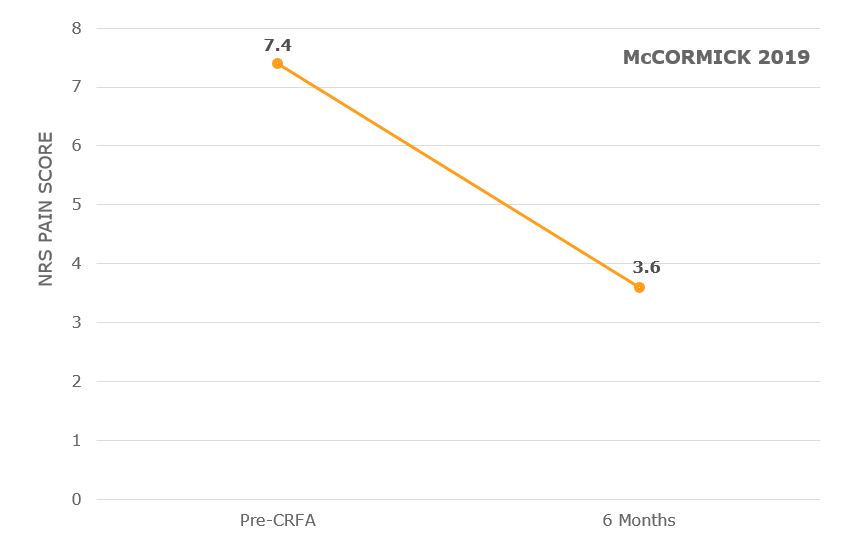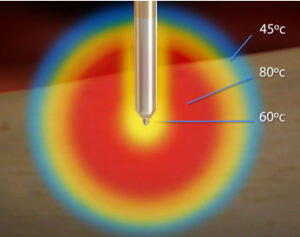The lumbar region is located in the lower back and supports the weight of the upper body. Low back pain (LBP) occurs in 70 to 85 percent of the general population and is the leading cause of lost work time, workers compensation claims and disability in US.1,2 15 to 45 percent of lumbar pain is caused by osteoarthritis (OA) and degenerative changes stemming from the facet joints.1,2 As patients age, spinal discs that were once filled with fluid start to shrink, placing stress on the facet joints.3
Limitations of Conventional Management Options
- Intraarticular joint injections (IA) or medial branch blocks (MBB) have fair to moderate efficacy, however they are associated with several adverse effects.4
- Physical therapy, neck traction and massage are unable to provide long-term analgesic benefit.1
 Advantages of Using COOLIEF* Cooled Radiofrequency
Advantages of Using COOLIEF* Cooled Radiofrequency
COOLIEF* Cooled RF is a minimally invasive procedure that ablates the nerves sending pain signals from the facet joint to the brain for up to 24 months.1 COOLIEF* Cooled RF is proven to be safe and effective for both patients seeking less-invasive pain relief intervention and those who are not appropriate candidates for surgery.
Specifically designed to treat complex anatomy of variable nerve courses, COOLIEF* Cooled RF uses water-cooled technology that enables more RF energy to safely deactivate pain-transmitting sensory nerves. This creates a larger, spherical lesion that distally projects 45% or greater beyond the probe’s tip, allowing physicians to approach the target nerve from any angle.
- Demonstrates up to 24 months pain relief with improved physical function and a reduction in opioid medication usage
- Delivers up to 3.7x more energy than standard RF
- COOLIEF* Cooled RF’s greater energy delivery leads to more extensive cellular disruption of the nerve as shown by histology
Comparing CRFA to SRFA in the Treatment of Lumbar Pain2
A 2019 randomized, prospective study published in Regional Anesthesia & Pain Medicine compared the effectiveness of CRFA versus SRFA in treating lumbar pain. 43 subjects were randomized to receive either CRFA or SRFA for the management of chronic lumbar pain. Subjects were evaluated for pain, function, quality of life and safety at one, three and six months using the Numerical Rating Scale (NRS), Oswestry Disability Index (ODI) and Patient Global Impression of Change (PGIC).
NRS Pain Scores for 6-Month Time Point

Pain
52.4% of subjects who received CRFA experienced ≥50% pain relief, compared to 50% of subjects who received SRFA.
Subjects who received CRFA reported an average decrease of 3.8 points from baseline NRS.
Alternately, subjects who received SRFA reported a 3.0 point decrease from baseline.
Disability
61.9% of subjects who received CRFA experienced >30% improvement in ODI score.
Comparably, 44.4% of subjects who received SRFA reported >30% improvement from baseline.
Subjects who received CRFA reported an average decrease of 11.3 points from the ODI baseline.
Comparably, subjects who received SRFA reported an average decrease of 8.1 points from baseline.
Key Takeaway: CRFA is effective in reducing lumbar facet joint pain at the 6-month time point.

Click here for Instructions for Use
References:
- Shih CL, Shen PC, Lu CC, Liu ZM, Tien YC, Huang PJ, Chou SH. A comparison of efficacy among different radiofrequency ablation techniques for the treatment of lumbar facet joint and sacroiliac joint pain: a systematic review and meta-analysis. Clin Neurol Neurosur. 2020;195:105854.
- McCormick ZL, Choi H, Reddy R, et al. Randomized prospective trial of cooled versus traditional radiofrequency ablation of the medial branch nerves for the treatment of lumbar facet joint pain. Reg Anesth Pain Med. 2019;44(3):389–397.
- Goode AP, Carey TS, Jordan JM. Low back pain and lumbar spine osteoarthritis: how are they related? Curr Rheumatol Rep. 2013;15(2):305.
- Pangarkar S, Miedema ML. Pulsed versus conventional radiofrequency ablation for lumbar facet joint dysfunction. Curr Phys Med Rehabil Rep. 2014;2(1):61-5.

 Advantages of Using COOLIEF* Cooled Radiofrequency
Advantages of Using COOLIEF* Cooled Radiofrequency